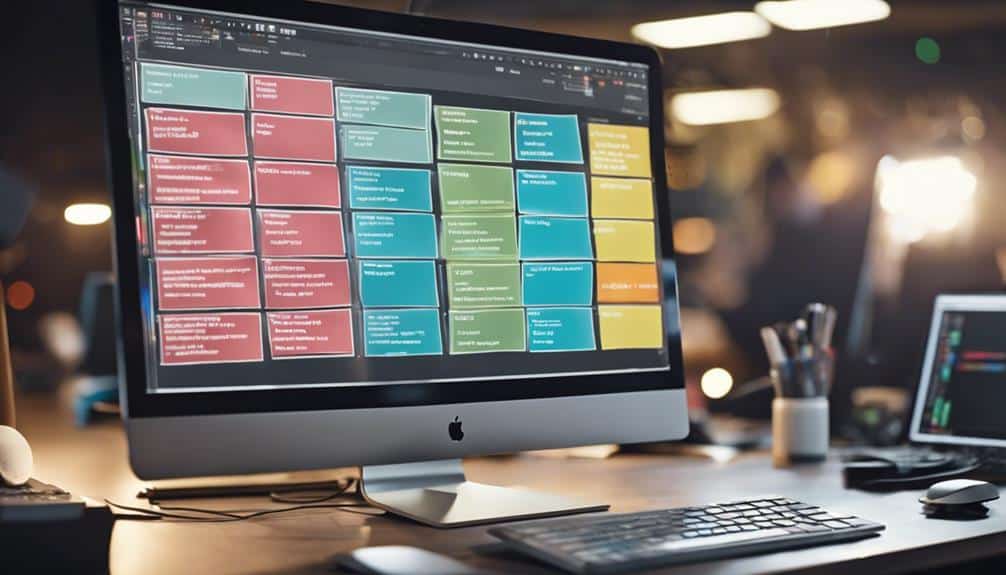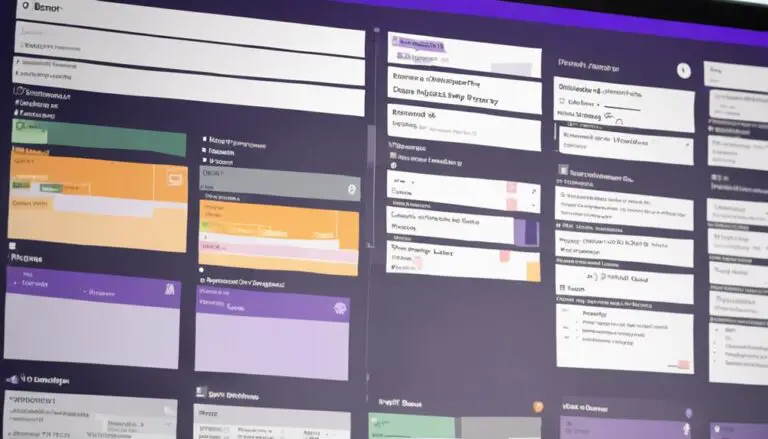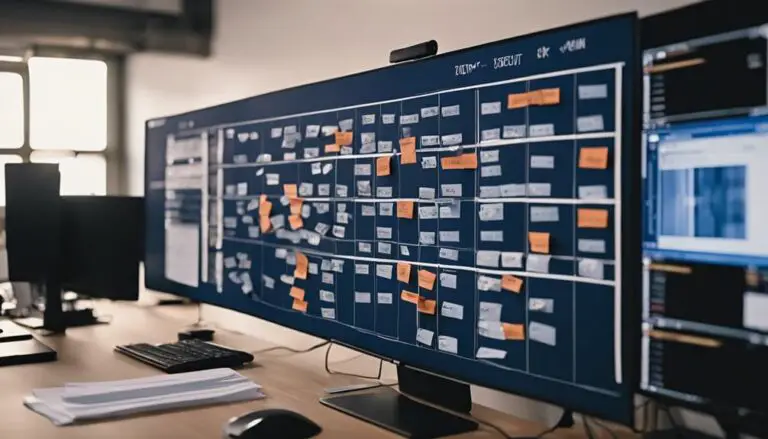Have you ever wondered how multiple Kanban boards can revolutionize your project organization?
The key lies in unlocking the potential of each board to cater to specific project aspects, enhancing clarity and focus for your team.
By implementing a few strategic practices, you can elevate your project management game and achieve greater success.
Let's explore together how these seven ways can transform your project management approach with multiple Kanban boards.
Key Takeaways
- Create separate boards for different teams or workstreams to streamline focus and enhance collaboration.
- Define workflow structures with specific stages and policies for efficient task management.
- Assign work to specific boards considering roles, dependencies, and project phases.
- Manage cross-board dependencies by prioritizing tasks, labeling items, and establishing transfer processes.
Setting Up Multiple Kanban Boards
When setting up multiple Kanban boards, begin by creating separate boards for different teams or workstreams to enhance visibility and streamline management. This approach is crucial in project management, especially when managing multiple projects simultaneously.
By assigning a dedicated Kanban board to each team, you can effectively avoid overload and maintain focus on specific tasks. It also allows for better organization and coordination within the team, ensuring that everyone is aligned with the project's goals and progress.
To further enhance project management efficiency, utilize features like Epics, Labels, and Components within each board to categorize and differentiate tasks effectively. Implement stable filters for each Kanban board to ensure a smooth workflow and prioritize tasks based on their importance.
Customizing board settings according to the unique workflow preferences and requirements of each team can significantly improve overall productivity and collaboration. By following these strategies, you can optimize the use of multiple Kanban boards and enhance your project management capabilities.
Defining Workflow Structures
To establish effective workflow structures, clearly delineate stages and steps within each process to ensure seamless progress and organization.
Allocating specific columns for different phases of work enhances work visibility, allowing team members to track tasks easily. Utilizing swimlanes further improves flow efficiency by segregating tasks based on priority, team, or project, streamlining the workflow process.
It's essential to implement explicit policies for each column, outlining guidelines for task progression and ensuring consistency across the boards. Regularly reviewing and optimizing workflow structures based on team feedback and performance data is crucial to maintaining efficiency.
Assigning Work to Specific Boards
When assigning work to specific boards, you're effectively delineating roles and tasks for each team or project, enhancing clarity and accountability.
Recognizing cross-board dependencies becomes crucial to ensure seamless workflow management and task completion.
Board Roles and Tasks
Consider assigning specific roles or team members to individual Kanban boards to facilitate streamlined work allocation and organization. By allocating tasks based on expertise or function, you ensure efficient project management across multiple boards.
Utilizing separate boards for various project phases or deliverables maintains clarity and enhances focus. Prioritizing and assigning tasks to boards based on dependencies or urgency can significantly improve workflow management.
Additionally, assigning work to boards considering geographical regions or time zones can enhance collaboration and communication among team members. This targeted approach to board roles and tasks ensures that each team member is working on tasks that align with their strengths and responsibilities, leading to a more productive and organized project execution.
Cross-Board Dependencies
Maximize efficiency in project management by strategically assigning work items to specific Kanban boards based on cross-board dependencies and team responsibilities.
By segregating tasks according to cross-board dependencies, you ensure that each board focuses on its designated set of tasks without unnecessary clutter.
Utilize classes of service to prioritize work items across boards, enabling a streamlined flow of tasks and efficient project progression.
Clearly label or tag each work item to indicate its respective board, facilitating easy identification and tracking.
Establish a well-defined process for transferring tasks between boards to maintain visibility and accountability.
Regularly review cross-board dependencies to optimize workflow efficiency and address any bottlenecks promptly.
Encourage team members to understand the board structure and navigate seamlessly between boards to access relevant tasks, fostering a cohesive project environment.
Establishing Clear Board Dependencies
To effectively manage dependencies between multiple Kanban boards, clearly defining relationships is essential. By establishing clear board dependencies, you can ensure a smooth workflow across all boards and projects. Here are some key strategies to help you achieve this:
- Use Linked Cards or Visual Indicators: Implement linked cards or visual cues to indicate connections and interdependencies between different boards.
- Establish Communication Protocols: Define communication protocols to help teams understand how their work on various boards impacts one another.
- Implement Cross-Board Policies: Introduce cross-board policies or rules to streamline workflows and ensure seamless coordination between boards.
- Regularly Review and Update Dependencies: Consistently review and update board dependencies to adapt to changes in project priorities and requirements.
- Ensure Consistency in Workflow: Maintain consistency in workflow processes across boards to facilitate the smooth progression of important work.
Streamlining Communication Channels
Establishing clear board dependencies ensures efficient workflow management, now turning our focus to Streamlining Communication Channels for enhanced team coordination and project visibility.
To optimize work and project delivery, assigning clear roles and responsibilities within each board is crucial. This reduces communication gaps and enhances collaboration, ensuring that everyone knows their tasks and how they contribute to the project's success.
Integrated tools or platforms for communication can centralize project discussions and updates, keeping all team members informed and aligned. Implementing standardized communication protocols and etiquettes fosters consistency and clarity in team interactions, making sure that messages are conveyed effectively.
Regularly syncing and aligning communication efforts among boards is essential to prevent misunderstandings and delays in project delivery. By streamlining communication channels, you can create a more cohesive and productive work environment, ultimately leading to successful project outcomes.
Monitoring Progress Across Boards
To effectively monitor progress across multiple Kanban boards, focus on cross-board progress tracking and consolidating board updates. By keeping an eye on how each project is advancing and combining updates from different boards, you can gain a comprehensive view of your team's overall progress.
This approach aids in identifying key areas that may require attention, ensuring projects stay on track and aligned with your objectives.
Cross-Board Progress Tracking
Implementing cross-board progress tracking in your project management strategy enhances visibility and coordination across multiple Kanban boards. By utilizing this approach, you can monitor the progress of tasks across different boards simultaneously, leading to improved project oversight.
Here are some key benefits of cross-board progress tracking:
- Easily identify bottlenecks, dependencies, and delays affecting project timelines.
- Gain a holistic view of project status by consolidating progress updates from various boards.
- Promote better coordination, collaboration, and alignment among different teams or workstreams.
- Enhance transparency, visibility, and accountability in managing interconnected tasks.
- Improve decision-making by having a comprehensive understanding of the overall project progress.
Consolidating Board Updates
By consolidating updates from multiple Kanban boards, you can efficiently monitor the progress of various projects and gain a comprehensive view of their overall status. This aggregation of information enables project managers and Agile Coaches to track task completion, identify project dependencies, and make well-informed decisions based on real-time data.
It fosters improved communication and collaboration among team members working on different boards, aligning everyone toward common project objectives. The process enhances transparency, reduces duplicated efforts, and streamlines project management effectively.
Through consolidating board updates, teams can collectively address bottlenecks or delays, ensuring smoother project progression and successful outcomes. This method not only simplifies monitoring progress across boards but also promotes a more cohesive and synchronized project management approach.
Implementing Regular Board Reviews
During your project management journey, incorporating regular board reviews is key to optimizing workflow efficiency and identifying areas for improvement. By conducting these reviews, teams can pinpoint bottlenecks and inefficiencies within their workflow, allowing for timely adjustments to priorities, work in progress (WIP) limits, and policies.
Analyzing metrics like cycle time and throughput during board reviews empowers teams to make data-driven decisions for better project management. These reviews also serve as a platform for continuous improvement, highlighting areas that require optimization and process refinement.
Moreover, regular board reviews ensure alignment with project goals, enable teams to address blockers effectively, and enhance overall productivity.
- Identify bottlenecks and inefficiencies in workflow
- Adjust priorities, WIP limits, and policies
- Analyze metrics like cycle time and throughput
- Facilitate continuous improvement
- Ensure alignment with project goals
Frequently Asked Questions
How Do I Manage Multiple Kanban Boards?
To manage multiple Kanban boards effectively, prioritize tasks, collaborate across boards for better team communication, and allocate time wisely. Customize settings per team needs, implement filters for organization, and ensure clear task prioritization for streamlined workflows.
How Do I Organize My Work With Kanban?
To organize your work with Kanban, focus on time management by setting realistic deadlines and prioritizing tasks. Use visual cues, like color-coded cards or swimlanes, to track progress easily. Regularly update and review to stay aligned with project goals.
What Are the 6 Rules of Kanban?
To implement Kanban principles effectively, focus on visualizing work, limiting tasks in progress, managing flow, setting clear policies, using feedback loops, and improving collaboratively. These rules guide agile methodology and enhance project management practices.
How Many Kanban Boards Should I Have?
You should have the number of Kanban boards that suits your project's complexity and scale. Multiple boards can help separate teams or phases. Avoid confusion by not making too many; consolidate related projects for clarity.
Conclusion
Now that you have learned the 7 key ways to organize your project with multiple kanban boards, it's time to put your knowledge into action. By implementing these strategies effectively, you can enhance collaboration, streamline workflows, and improve project management efficiency. One way to further enhance your project management efficiency is to use epics in project management. Epics are large bodies of work that can be broken down into a number of smaller tasks. By breaking down your project into epics, you can more easily track progress and keep your team focused on the most important tasks. Additionally, using epics can help you prioritize work and allocate resources more effectively.
Stay tuned for more tips and tricks to optimize your project management process and achieve successful project delivery. Keep exploring and innovating to unlock the full potential of your team and projects.





